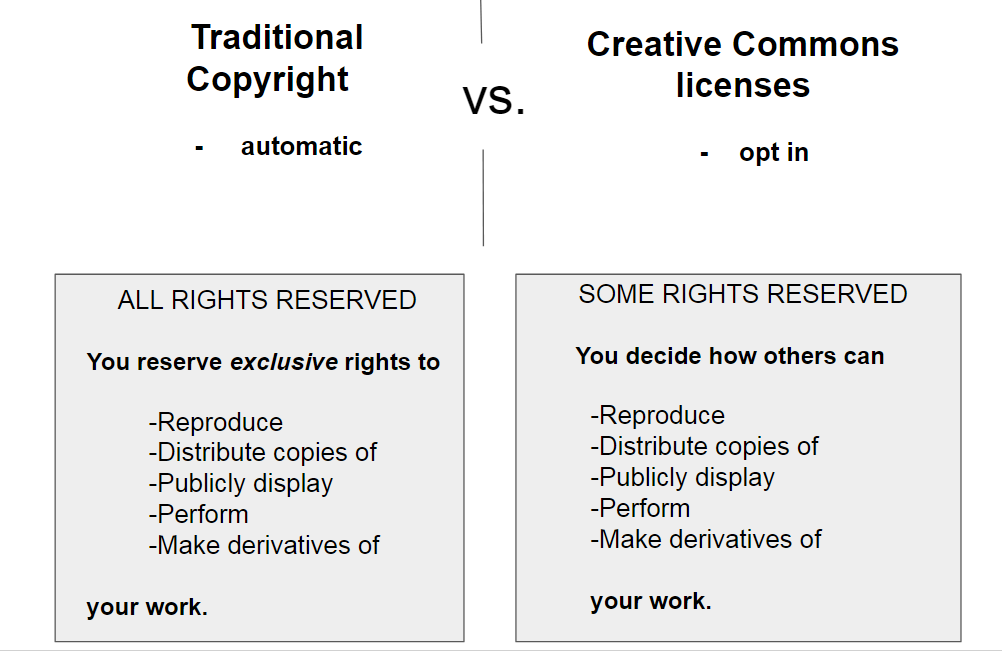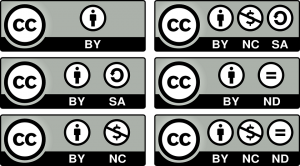Defining Open Educational Resources
Open educational resources (O.E.R.) are cost-free and openly licensed educational materials that can be used for teaching, learning, research, and other purposes. This definition comes from the Creative Commons organization.
In other words, O.E.R.:
- Are teaching materials that can be shared freely, and
- Provide explicit permission (in the form of a license) to adapt the materials for customization
What’s the difference between learning materials we describe as “O.E.R.” and learning materials we describe as “zero-cost” or “free?”
The critical thing that sets O.E.R. apart from cost-free resources is that they have what is colloquially referred to as “open licenses.” This means the author/creator has chosen an intellectual property license to allow their work to be available for others to use, share, and even update, revise, or build upon.
This is achieved by authors selecting a Creative Commons license for their work. These licenses provide a transparent way for authors to give permission for users to:
- Retain – permission to own, archive, and make copies of the content
- Reuse – permission to reuse content in its unaltered form
- Revise – permission to adapt, adjust, modify, and alter content
- Remix – permission to combine original or revised content with other content to create something new
- Redistribute – permission to share copies with others in its original, revised or remixed form
Are O.E.R. online materials only?
No. O.E.R. can be any type of educational content: a video, a simulation, an image, a blog, a podcast, a textbook, or any variety of textual material, like lecture notes. O.E.R. are often delivered in digital formats online, but they can be in print as well. The way to determine if a learning material is O.E.R. is by looking for the intellectual property license. If you see it has a Creative Commons license that lets you edit and remix the material to suit you, then you can call it OER! We’ll spend more time investigating Creative Commons licenses in our first meeting together.
Creative Commons licenses
A review: The Creative Commons organization was founded in 2001 by legal scholars, artists, and activists to develop a legal framework that runs parallel to U.S. copyright law so that authors of creative and intellectual materials could retain their copyright, and decide how others use their work. They wanted to find some middle ground between the restrictions of traditional copyright and the ‘free wheeling’ public domain. This ethos is related to the free culture movement, the open source software movement, and the open access movement in scholarly publishing.
Read about the three layers (legal code, human readable, machine readable) of licenses on the Creative Commons website.
The image below shows the 5 icons that represent different components of CC licenses.
Types of Creative Commons licenses
There are six types of Creative Commons licenses to choose from. They are opt in, meaning they’re entirely your decision to choose and you don’t need to register or pay to select one. Each license gives you a range of possibilities as to how openly you want to share your work.
For a learning material to be considered O.E.R., it should allow these 5 permissions:
- Retain – the right to own, archive, and make copies of the content
- Reuse – content can be reused in its unaltered form
- Revise – content can be adapted, adjusted, modified, and altered
- Remix – original or revised content can be combined with other content to create something new
- Redistribute – copies of the content can be shared with others in its original, revised or remixed form
This quick video provides a recap.
It’s important to recognize that not all Creative Commons licenses permit adaptation. Specifically, Non-Derivative (ND) licenses, do not permit others to adapt the material to be shared publicly.
The image below outlines the licenses on a scale of most to least permissions.
Try out the Creative Commons License Chooser.
Best Practices
As a creator of intellectual content, you can use the Creative Commons license chooser to help you decide what license works for you.
As an adopter of OERs, you always need to attribute the work of others.
Just like you cite and provide references in your scholarship, when you teach with course materials developed by someone else, you should always attribute materials by displaying the name of the author and the type of CC license that accompanies their work.
By properly attributing the author you ensure:
- The intellectual property rights of the author are preserved (all CC licenses require you to cite the author to be in compliance with the license…emphasis on the “BY”)
- The provenance of the work is documented – this is fundamental to tracing authority and relevance of course materials
- Clear indication of exactly how the resource can be shared or customized based on the provisions of the CC license (for ex., Does the license allow commercial or non-commercial use?
- Any non-OER materials can be distinguished from CC licensed materials (Non-OERs might be library subscribed material or newspaper articles) so as not to confuse or misrepresent information to potential adopters
You’ll notice there is a Creative Commons license for this site (on the bottom footer of the page). It’s convenient to embed the CC license icon and URL on websites and digital files. There is also a new custom OpenLab widget, that allows you to select your CC license without leaving your site!
Selecting materials for your O.E.R.
Of course there are many materials relevant to incorporate into your teaching that are not O.E.R. That is why we also recommend Fellows assign other cost-free materials to students in addition to O.E.R. For example, you can continue to assign materials freely available on websites by linking out to them, as well as digital resources from the City Tech Library.
Materials O.K. to include in your overall O.E.R.:
- Public domain materials
- Open Access materials (journal articles and books)
- Library Digital Resources
- Free online that you can link to
Materials NOT O.K. to include in your O.E.R.:
- Copyright protected materials
How is the end result called an O.E.R.?
Even though not every material you assign will fit the definition of an open educational resource, what makes you be able to call your overall course site an O.E.R.?
- You will make the overall site available to the public and you will select a Creative Commons license that permits others to adapt your work
- Course content developed by you (which can include homework assignments, lecture slides, etc.) is original content that you will share under a Creative Commons license
- Your site will be following best practices outlined in the Fellowship with respect to intellectual property, etc. For example, we will review how to incorporate images that are in the public domain or Creative Commons licensed, to reinforce a culture of sharing and adapting
Connecting open education to pedagogy
Open pedagogy seeks to extend the idea of openness, access, and equity beyond selection of course materials and into teaching and learning practices.
What is open pedagogy?
The definition of open pedagogy is actively shifting, co-created by educators in dialogue across journals, blogs, and social media. Rather than a static definition, many advocates treat open pedagogy as a set of values and priorities on which to base their teaching, including learner-centeredness, accessibility, and prioritizing linguistic and cultural relevance.
According to the Open Pedagogy Notebook, we can think of open pedagogy as “…an access-oriented commitment to learner-driven education AND as a process of designing architectures and using tools for learning that enable students to shape the public knowledge commons of which they are a part.”
Some materials and activities that fall under the umbrella of open pedagogy include:
- Non-disposable assignments, i.e. “…assignments that are sustainable or not disposable, assignments that would have benefit to others beyond the limited course time and space” (Bali 2017)
- Students contributing to assignment design, co-constructing course materials, such as created a collective annotated bibliography on a research topic
- Students conducting and presenting research to the wider public through various publishing forms (conference presentations, podcasts, etc.)
Take this short quiz to test your knowledge
Print this page








